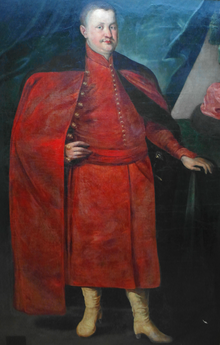Konstanty Wasyl Ostrogski
Konstanty Wasyl Ostrogski | |
|---|---|
 Portrait by Peeter Danckers de Rij | |
| Coat of arms | Ostrogski |
| Born | 2 February 1526 Ostróg, Polish-Lithuanian Commonwealth |
| Died | 23 or 13 February 1608 (aged 82) Ostróg, Polish-Lithuanian Commonwealth |
| Noble family | Ostrogski |
| Spouse(s) | Zofia Tarnowska |
| Issue | Elżbieta Ostrogska Janusz Ostrogski Katarzyna Ostrogska Konstanty Ostrogski Aleksander Ostrogski |
| Father | Konstanty Ostrogski |
| Mother | Aleksandra Słucka |
Konstanty Wasyl Ostrogski (2 February 1526 – 13 or 23 February 1608, also known as Kostiantyn Vasyl Ostrozky, Ukrainian: Костянтин-Василь Острозький, Belarusian: Канстантын Васiль Астрожскi, Lithuanian: Konstantinas Vasilijus Ostrogiškis, Polish: Konstanty Wasyl Ostrogski) was an Orthodox magnate of the Polish-Lithuanian Commonwealth, a Ruthenian prince, starost of Volodymyr-Volynskyi, marshal of Volhynia and voivode of the Kiev Voivodeship. Ostrogski refused to help False Dmitriy I and supported Jan Zamoyski.
The date of birth of Konstanty Wasyl Ostrogski is disputed. According to some historians he was born around 1524/1525.[1]
He was born probably in Turów.[2]
In the 1570s he waged a war against another magnate, Stanisław Tarnowski, about disputed possession of estates in the area of Tarnów, in Lesser Poland.
Prince Ostrogski was of Eastern Orthodox faith and he was active in supporting the Orthodox Church (see Union of Brest). He was also a promoter of Eastern Christian culture in the Polish–Lithuanian Commonwealth. Around 1576[3] he established the Ostroh Academy, a regarded humanist educational and scholarship institution, with the instruction in Greek, Latin and Old Church Slavonic languages. In 1581 the Academy produced and published the Ostrog Bible, the first complete printed edition of the Bible in Old Church Slavonic.[4]
Ostrogski's huge latifundium, or landed estate in the eastern Polish–Lithuanian Commonwealth, consisted of 100 towns and 1300 villages.[5] It was Ostrogski who built Starokostiantyniv Castle.
While Konstanty Wasyl Ostrogski was the proponent of the Eastern Orthodox religion, his son Janusz Ostrogski converted to Roman Catholicism.
He was married in January 1553 in Tarnów.
See also
References
- ^ Kempa, Tomasz (1996). "Konstanty Wasyl Ostrogski wobec katolicyzmu i wyznań protestanckich". Odrodzenie i Reformacja. 40: 17. Retrieved 22 September 2015.
- ^ Kempa, Tomasz (2002). Dzieje rodu Ostrogskich. Wydawnictwo Adam Marszałek. p. 79.
- ^ Kempa, Tomasz (1996). "Konstanty Wasyl Ostrogski wobec katolicyzmu i wyznań protestanckich". Odrodzenie i Reformacja. 40: 19. Retrieved 22 September 2015.
- ^ A Concise History of Poland, by Jerzy Lukowski and Hubert Zawadzki. Cambridge: Cambridge University Press, 2nd edition 2006, ISBN 0-521-61857-6, p. 86-87
- ^ Józef Andrzej Gierowski - Historia Polski 1505-1764 (History of Poland 1505-1764), p. 193, Państwowe Wydawnictwo Naukowe (Polish Scientific Publishers PWN), Warszawa 1986, ISBN 83-01-03732-6
External links
- Ostrozky, Kostiantyn Vasyl / Ostrozky in the Encyclopedia of Ukraine, vol. 3 (1993)
- a chapter of the "History of Russia" by Nikolay Kostomarov devoted to "Knyaz Konstantin Konstantinovich Ostrozhskiy" Template:Ru icon
